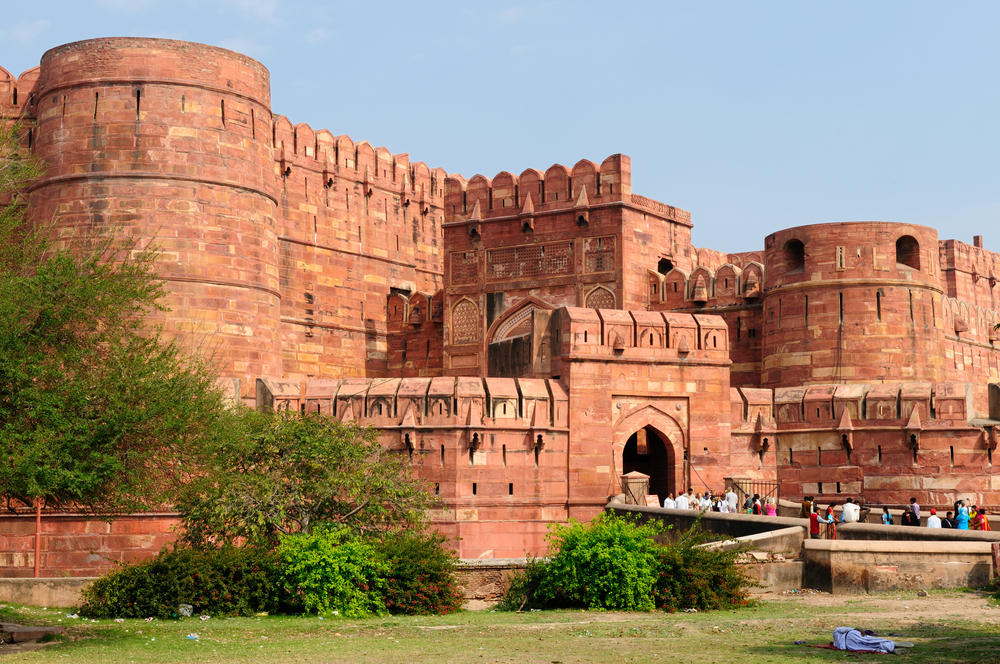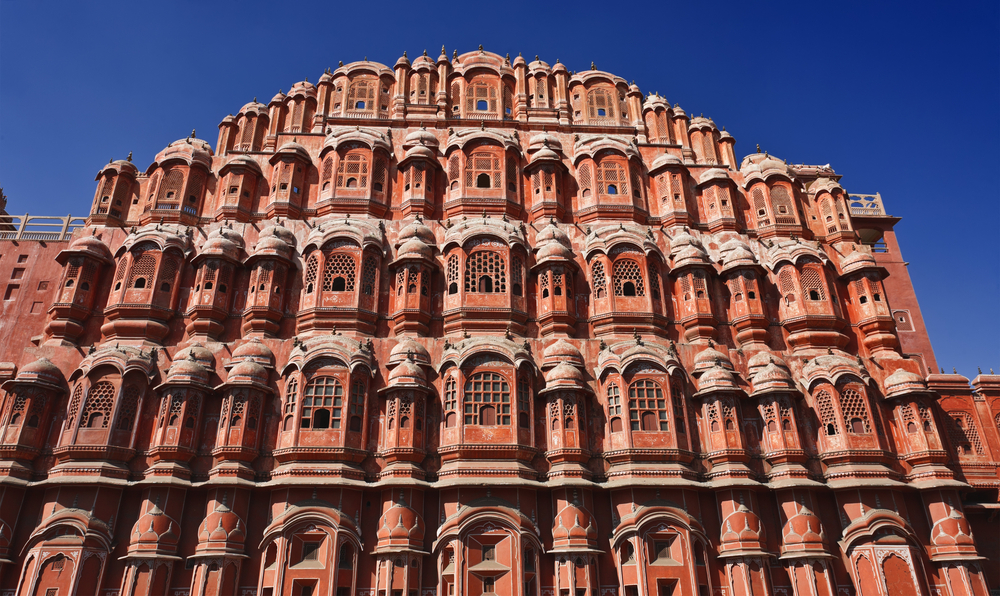
Classical India Tour
One of its kind, the Classical India tour is an ideal choice for the first-time visitors. It includes some of the best known culturally rich and historically significant highlights of India. The odyssey starts from the capital city, Delhi, an active metropolis, with a unique combination of the ancient and the contemporary era. The tour then takes a twirl to the dwelling of the world’s famous tribute of love, the Taj Mahal in Agra. The tour then gradually advances its pace in the vicinity of valor and gallantry, Rajasthan, and in the midst of this beautiful state, you then step on to the city that unrolls a pink carpet to all its visitors, Jaipur. The trail then goes on to the blue city, Jodhpur followed by the Venice of the east, Udaipur. The Classical India tour ends in Delhi, where you will have an opportunity for some last-minute shopping, at some of the famous street markets, or even the modern stores, that Delhi is now famous for.
- Tour Duration: 10 Nights / 11 Days
- Places Covered: Delhi(2) > Agra(1) > Jaipur(2) > Jodhpur(2) > Udaipur(2) > Delhi(1)
-
Day 1: Arrive Delhi
On your arrival at the Delhi International Airport, you will be received by a Trans India Holidays representative and will be escorted to the hotel. He will then help you with the check in formalities. Your Classical India tour starts from the capital city, Delhi, an energetic city, with a unique blend of the ancient and the contemporary era. Delhi has two visible parts: New Delhi, the city created by the British in 1911 as the Imperial capital of India and Old Delhi considered as the Muslim capital of India between the 17th and the 19th century. There are atleast eight cities on the location of the modern Delhi, among which Indraprastha is one of the first recognised settlement, highlighted in the epic Mahabharata over 3000 years ago. Nevertheless, Delhi has always been one of the major cities in the northern region of the subcontinent.
-
Day 2: In Delhi
After breakfast, you will be picked up from your hotel and taken for a guided sightseeing tour of Old & New Delhi. Tour includes visits to the following places of interest: Red Fort: The name Red Fort is taken from a Hindi word Lal, which means red owing to the red sandstone and Quila which means fort. Set along the Yamuna River, the octet shaped fortress is surrounded by a wall of about 2.4 kms in the perimeter. In 1638, Shah Jahan started building this huge fort and it took 10 years to complete. The fort has a Diwan-e-Am (Hall for public audience), a Rang Mahal (a water-cooled apartment of royal ladies) and a Pearl Mosque, which was constructed with white marble. Red fort has two hallways: a) The Delhi gate and b) The Lahori gate, and both these gates face the renowned Chandni Chowk. Jama Masjid: Set in the Old Delhi also known as Shahjahanabad, Jama Masjid is one of the country’s major mosques where hundreds and thousands of Muslims offer their prayers. The architectural extravaganza was built by Shah Jahan in 1658. The wonders of construction are seen in the long stretches of stairs and the hefty courtyard of the Jama Masjid. Chandni Chowk (Silver Street): Well-known for its flamboyant streets that have earned the reputation of being the famous shopping spots of Old Delhi, Chandni Chowk is the country’s best known extensive market for textiles, electronic goods, and watches. Entire Chandni Chowk was designed by Jahanara Begum, Shah Jahan’s beloved daughter and was then populated by the well-to-do families of that time. The famous Parantha wale Gali, known for its mouthwatering paranthas is also positioned in Chandni Chowk. The famous gold market, Dariba Kalan is also situated here. Raj Ghat: An elementary square platform of black marble on the banks of Yamuna River, symbolizes the spot where Mahatma Gandhi was cremated followed by his assassination in 1948. A dedicatory ritual takes place each Friday, in his memory. India Gate: India Gate is a free-standing, 42-metre high arch. It was built in 1931 and was formerly called the All India War Memorial in the memory of the 90,000 soldiers of the Indian Army who died in World War I. The names of the warriors are engraved all along the walls of the arch. The eternal flame was lit here to honor the Amar Jawan (Immortal Soldier), in 1971. Rashtrapati Bhavan (President’s House): Rashtrapati Bhavan is the authorized residence of the President of the country. It was designed by Lutyens and was the official residence of the Viceroy when the British ruled India. Humayun’s Tomb: Nine years after the death of Humayun, Haji Begum (widow of Humayun) built this tomb in 1565-66 in his memory. Qutub Minar: This outstanding building in the Southern part of the capital was built by the Muslim King; Qutab–ud–din Aibak in 1199 A.D. The Minar (tower) is 72.5 meters tall and its base is a mosque. Overnight stay in Delhi.
-
Day 3: Drive Delhi - Agra (220 kms/04 hrs)
You will be met by one of our representatives who will assist you with the check-out formalities. You will then start your trail to Agra, the next stop on your Golden Triangle tour package. The drive from Delhi to Agra will be via the new Express way, one of India’s finest highways. Agra is situated on the bank of Yamuna River. It is the dwelling place to India’s famous monument, the Taj Mahal. Agra was the capital of Mughal Empire in the 16th & 17th centuries. On your arrival at the hotel in Agra, you will again be met by our representative and will be assisted with check in formalities. Later in the afternoon, the tour guide will pick you up for the guided sightseeing trip of Taj Mahal and the Agra Fort. Taj Mahal: Emperor Shah Jahan constructed the Taj Mahal in the memory of his wife Mumtaj Mahal who died during the birth of their child in 1631. The construction of this famous monument is said to have taken 22 years, starting from 1631.Over 20,000 artisans were working day and night for the construction of this landmark. Craftspersons and whizzes were brought from France and Italy. And the chief architect was from Iran. The visit to the Taj Mahal, will long be remembered by you as the highlight of your Golden Triangle Tour. Agra Fort: Emperor Akbar started the construction of this huge red sandstone Agra Fort on the bank of Yamuna River in 1565. It was mainly constructed for the soldiers until his grandson, Shah Jahan, added more opulent accommodations. There are a number of attractive buildings within its porches such as Samman Burj, where Shah Jahan was imprisoned by his son, Moti Masjid, a white marble mosque, Diwan–e–Am, Diwan–e–Khas, Jahangir’s Palace, Khaas Mahal and Shish Mahal. Overnight stay in Agra.
-
Day 4: Drive Agra - Jaipur (250 kms/05 hrs)
After a relaxed breakfast at the hotel, you will be received by our representative and will be assisted with check-out formalities. You will then start your trip to Jaipur. Stop at Fatehpur Sikri for the guided tour of this ancient capital. Fatehpur Sikri: The deserted capital of Emperor Akbar roughly 35 kms outside Agra, this city was built in the 16th century, and was abandoned for 12 years due to the paucity of water. The entire city is still intact, and a sight of this city is worth remembering. The Buland Darwaza, is the main entrance to this city, which is 54 m tall and this gate was built in the honor of Akbar’s victory in Gujarat. After visiting Fatehpur Sikri, the drive takes a twirl to Jaipur, the third destination that forms India’s Golden Triangle. Jaipur: It is the capital of Rajasthan, and is known as the “Pink City” because of the pink tinted constructions in the old city. It is situated on a dry lake bed, bordered by barren hills vanquished by forts and broken walls. The city was found in 1727 by Maharaja Jai Singh II, who wanted to be in the good books of the then ruling Mughals. He positioned the city with rectangular blocks according to early Hindu architecture. It is a great city for shopping. On arrival at the Jaipur hotel, you will again be received by our representative and will then be assisted with check in formalities. Overnight stay in Jaipur.
-
Day 5: In Jaipur
After the morning meal, you will be picked up by the guide from the hotel and will be taken for a guided sightseeing tour of Jaipur and Amber. Sightseeing in Jaipur includes : Hawa Mahal (Palace of winds): Constructed by Maharaja Sawaj Pratap Singh in 1799, the Hawa Mahal is one of the Jaipur’s main landmarks, the front of the Mahal has pink windows and latticework screens. This mahal was initially constructed for the ladies of the imperial household to watch the ordinary life and parades of the city. City Palace: The City Palace is still the dwelling of the former royalty H.H Bhawani Singh Ji of Jaipur. This Palace still has an extensive collection of art, carpets and old weapons. Jantar Mantar (Observatory): It was built by Maharaja Jai Singh in 1728. Jantar Mantar appears to be an inquisitive collection of sculptures but in fact each construction has a detailed purpose such as measuring the positions of stars, altitudes and azimuths, and calculating eclipses. The most striking instrument is the sundial which is 27 meter tall gnomon. The shadow this casts moves up to 4 meters an hour. Amber Fort: The Amber Fort is located 11 kms away from Jaipur. Amber was once the ancient capital of Jaipur. The Fort is an excellent illustration of Rajput architecture, impressively situated on a hillside facing a lake, which reflects its walkways and walls. Overnight stay in Jaipur.
-
Day 6: Drive Jaipur – Jodhpur (330 kms/07 hrs)
After a relaxed breakfast at the hotel, you will be met by our representative and he will help you with check-out formalities. You will then start your journey to the blue city, Jodhpur, the next stop on your Classical India tour. Jodhpur is famous as the 'blue city' because of its blue cottages. The lively desert city of Jodhpur stands at the fringe of the Thar Desert and is the second major city of Rajasthan after Jaipur. The city is differentiated by a huge fort that covers a sheer rocky ridge rising in the heart of the town. The old city is still delimited by a 10 km long wall, made about a century after Jodhpur was established. There are eight gates leading out of the old city. You can take a stroll through the beautiful winding streets. The city of Jodhpur was founded in 1459 by Rao Jodha, the chief of a Rajput clan known as Rathores and was earlier called Marwar. On your arrival at the Jodhpur hotel, you will again be met by our representative and will be assisted with check in formalities. No activities are planned for the day. Spend the rest of the day enjoying and relaxing in the hotel or exploring the city. Overnight in Jodhpur.
-
Day 7: In Jodhpur
After breakfast, the guide will pick you up from the hotel for a guided sightseeing tour of Jodhpur. Tour includes the following places of interest: Mehrangarh Fort: Rested on a hilltop, it takes five kilometres by a curvy road to reach Mehrangarh. Mehrangarh is considered by many as the most striking fort in Rajasthan. Initially built by Maharaja Jodha Rao, the fort was further succeeded by the rulers of Marwar. Of the seven huge gates to the fort, a few like Jayapol and Fatehpol were built to celebrate Marwar rulers' victories over countless enemies. Inside the fort is a series of courtyards and palaces. If you enter through Surajpol, the Jodhpur Museum stocks a brilliant collection of relics of Rajasthan. Jaswant Thada: Located close to the Mehrangarh Fort, is the white marble war memorial of Maharaja Jaswant Singh II, known as the Jaswant Thada. The best way to explore and experience the city of Jodhpur, is to take a fascinating walk around the colorful Sardar market and the Clock Tower. Besides experiencing the culinary delights of Jodhpur in the small local restaurants, the antique shops are also worth a visit. You can relax for the rest of the day or explore the city on your own. Overnight in Jodhpur.
-
Day 8: Drive Jodhpur – Udaipur (275 kms/ 6 hrs)
After a relaxing breakfast at the hotel, you will be met by our representative and will be assisted with check out formalities. You will then start your drive to Udaipur, the final stop on your Classical India tour. Udaipur, literally meaning “the city of Sunrise”, was established by a Rajput King, Maharana Uday Singh, in 1567, and this city is now also known as the "city of Lakes" and also the "Venice of the East" Udaipur is a moony lake city with its marble whims, attractive hibiscus-covered gardens and elegant fountain porches, which symbolize the glory of Rajput era. Like many other cities in Rajasthan, Udaipur is the heirloom of an honor-bound race that loved the good things in life and often gave up their lives protecting them. On your arrival at the hotel in Udaipur, you will be again be received by our representative and he will assist you with check in formalities. Overnight stay in Udaipur.
-
Day 9: In Udaipur
After breakfast, the guide will pick you up from the hotel and take you for a guided sightseeing tour of Udaipur. Tour includes following places of interest: City Palace: The biggest palace complex in Rajasthan is the grand City Palace towering above the lake. The major parts of the palace are now well-maintained as a museum with an enormous collection of glass, ceramic figures and small canvases. Jagdish Temple: The famous Jagdish Temple is situated 150 mts from the City Palace. This fine Indo-Aryan Temple was constructed by Maharana Jagat Singh in 1651. This temple treasures a black stone image of Lord Vishnu as Jagannath, Lord of the universe. A brass image of Garuda the Hindu divinity is in a monument in front of the temple. Saheliyon Ki Bari: The Saheliyon ki Bari or the garden of the Maids of Honor is situated in the north of the city. It is a small exquisite garden with fountains, stone elephants and a beautiful lotus pond. Lake Pichola: Lake Pichola derives its name from Pichali village. This lake is fenced by hills, palaces, temples, bathing ghats and ridges. There are two island palaces in the Lake Pichola, the Jag Niwas and the Jag Mandir. Jag Niwas was built as the summer residence of Prince of Mewar and is now the famous Lake Palace hotel. The Jag Mandir is built of red sandstone with a marble ceiling. An enchanting way to end your day in Udaipur is by taking a beautiful boat ride in the evening when the City palace in the background unites with the sparkling lake water. Rest of the day you are free to relax and enjoy the scenic beauty of the city. Overnight stay in Udaipur.
-
Day 10: Fly Udaipur - Delhi
After a relaxing breakfast at the hotel, you will be met by our representative and will be assisted with check-out formalities. You will then be escorted to airport in time to board flight for Delhi. You will then again be received at the airport by our representative and will be escorted to the hotel and will be assisted with the check in formalities. Rest of the day is free for you to relax and spend your time either at the hotel or exploring the city. Overnight stay in Delhi.
-
Day 11: Depart Delhi
Have a relaxed morning at your hotel, or take in some last minute shopping. After a 1200 hrs (noon) check out, you will be met by our representative at the hotel and will be assisted with checkout formalities. He will then escort you to the airport for your flight back home.

Date & Price
Price
| Period | Standard | Superior | Deluxe |
|---|---|---|---|
| Valid from 16 Apr 2025 to 30 Sep 2025 | $ 1327 Per Person | $ 1425 Per Person | $ 1671 Per Person |
| Valid from 01 Oct 2025 to 15 Apr 2025 | $ 1593 Per Person | $ 1758 Per Person | -NA- |
| Valid from 01 Oct 2025 to 15 Apr 2026 | -NA- | -NA- | $ 2190 Per Person |
- Domestic airfare: USD 130 per person
Accommodation
| Cities | Standard | Superior | Deluxe |
|---|---|---|---|
| Jodhpur | Karni Bhawan | Ajit Bhawan | Taj Hari Mahal |
| Udaipur | Fateh Niwas | The Lalit Laxmi Vilas Palace | Fateh Prakash Palace |
| Delhi | Park Inn by Radisson | The Park | The Lalit |
| Agra | Howard Plaza-The Fern | Jaypee Palace | ITC Mughal |
| Jaipur | Alsisar Haveli | Lemon Tree Premier | ITC Rajputana |
Important Information
- Small supplements may apply for travel between 25th October and 15th November, 20th December and 05th January and during the month of February.
- All the figures quoted above are net per person in US Dollars.
Inclusions
- Accommodation on twin sharing, bed & breakfast basis at the selected categories of hotels.
- Ground transportation as mentioned in the itinerary using an air-conditioned car.
- Sightseeing tours as per the itinerary along with an English speaking guide and including entrance fees to the monuments.






















